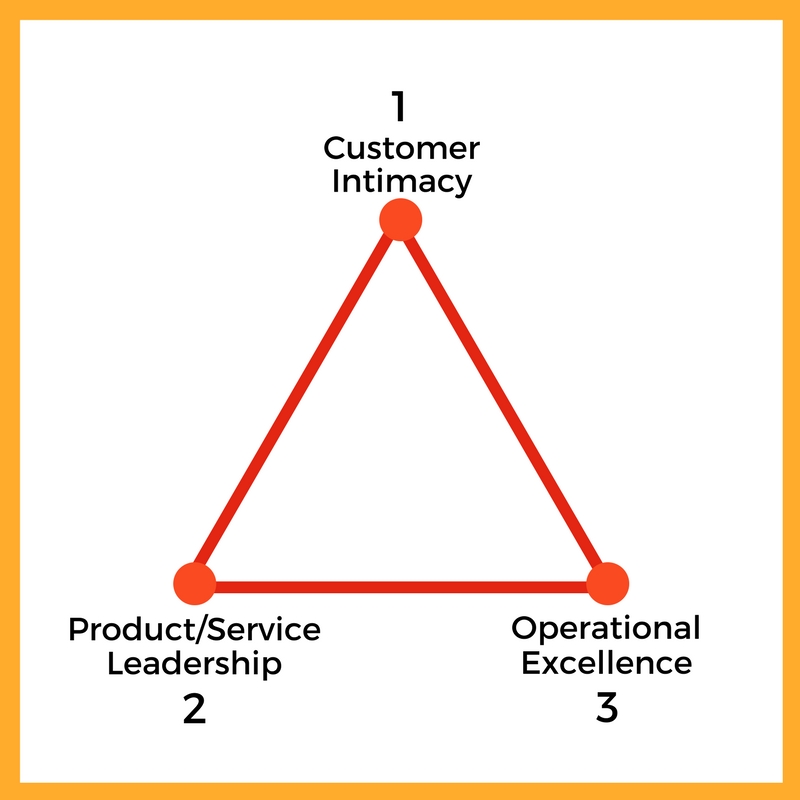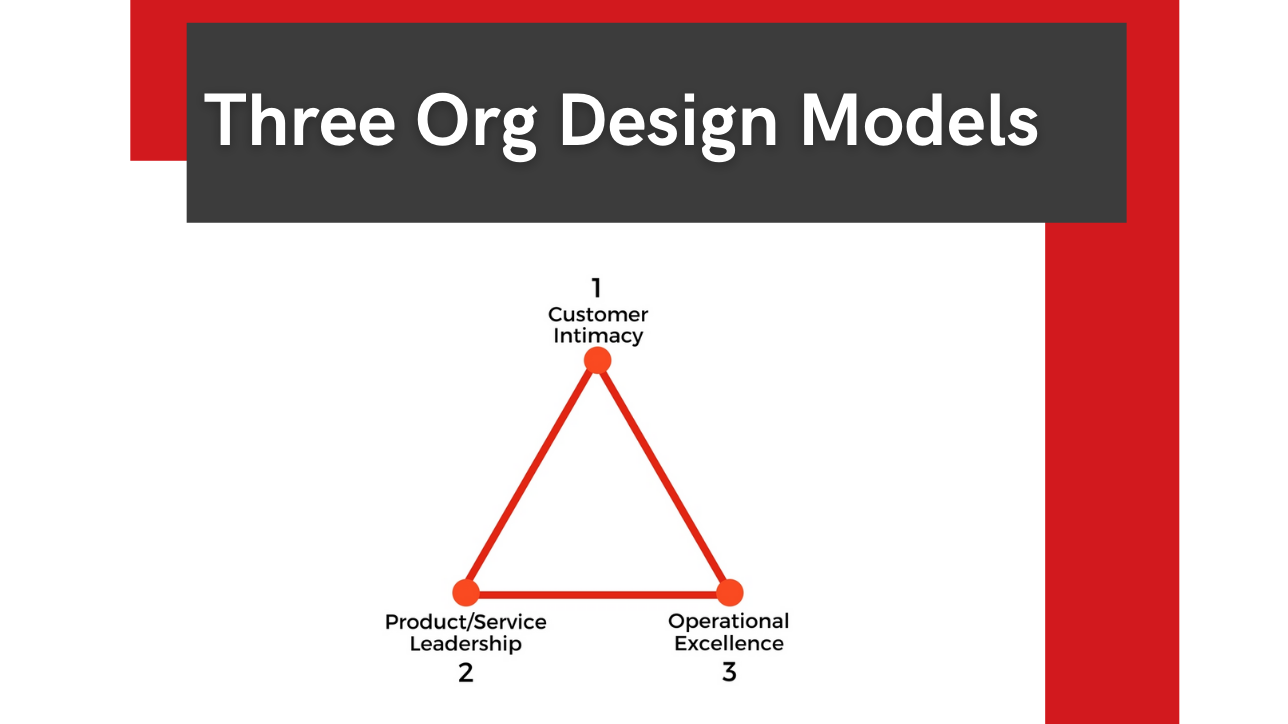In 1993, Michael Treacy and Fred Wiersema stated that a business (for profit, not for profit, government, function/department) has a choice of three value disciplines to pursue. ON THE MARK (OTM) describes this as the Gravitational Pull of an organization.
We categorize these value disciplines or Gravitational Pulls as:
A business must pick one of the three as their primary Gravitational Pull. A business that does not choose one or tries to compete on more than one will fail. As Jack Welch famously said, ‘If you don’t have a competitive advantage, don’t compete.’
Each Gravitational Pull provides a business with a specific competitive advantage and requires very different operating model templates. What is your business trying to be in the marketplace?
Take a look at the three primary types of organization design models.
Types of Organization Design Models
 1. Customer Intimacy Model
1. Customer Intimacy Model
Customer intimacy means knowing your customer and their needs intimately. This could also be knowing their specific needs better than the customer knows them. This knowledge allows a business pursuing customer intimacy to deliver tailored product, services or solutions to the customer. Customer intimate businesses are usually driven by touchpoints making doing business easy for the customer. We describe this as ‘insourcing complexity’. It is also important to note that customer intimacy is not the same as customer service. Maintaining a high level of customer service is a basic requirement of any business.
Practical example:
Imagine a large FMCG company, selling to a large retailer which manufactures 10 different products, each supported by a different sales organization.
In one week, the customer could receive 10 different visits from 10 different product salespeople from the FMCG company, leaving the customer bombarded with sales. They then must place multiple orders with the same company.
This describes a highly functional organization which is not set up to achieve Customer Intimacy. In a customer intimate model, the FMCG company would have one representative for the visits to the customer, who then manages all of those product lines behind the scenes. This makes it simple for the customer to do business with them.
This requires greater coordination internally for a company. Customer-intimate organizations must organize around making business transactions simple. Larger organizations also tend to rely heavily on insight and technology to maintain the knowledge about the customer.
You are also likely to see structural features such as customer segments, account managers or staff physically being co-located with the customer.
Pricing In Customer Intimate Organizations
In customer-intimate operating models, customers often pay more because they place value on the experience they garner from customer-intimate businesses. So, if you have a deep relationship with a company, and when they’re customer-intimate, you’re willing to pay for that experience.
Case in point: Look at Four Seasons Hotels, for example–they’re not cheap.
It doesn’t matter where in the world you pull into a Four Seasons, they’ll treat you to a highly personalized experience that makes you feel like you have a relationship with each staff member.
They know things about you and they know your patterns. Ultimately, you’re going to pay more for customer intimacy.
2. Leadership & Innovation for Products & Services
A product or service leader strives to put the most innovative product or service on the market. Features of product and service leadership include ensuring they have specialism, functional expertise, operate projects or programs of work, and are set up to foster innovation and creativity.
For instance, take a look at Apple. They may have engineers focusing solely on a single element of the screen. Just recently, they also hired sleep experts to conduct research which will presumably be integrated into future products. All these components must come together, but it starts with deep specialists in each of their areas looking at new features, product or services and new ways to do it.
The big challenge in a business pursuing product/service leadership relying on functions and specialists is this: How do they bring them together to coordinate the end-to-end value stream?
Typically, they use agile teams where they come together while working on versions of an iPhone and use cross-functional teams running through the organization. A cross-functional team involves a product team looking at the next iteration of the iPhone.
So you’re taking all of our expertise and you’ve got to put it together on this cross-functional team. In product-innovative organizations, it’s about getting things to market, with the newest materials, and ultimately having the best product out there.
Pricing In Product Leadership
In pricing, there’s no haggling with Apple, for example. If you want the iPhone, then you pay for it. All over the world — take the currency right out — an iPhone is the same price. That’s an indicator of product leadership companies: you pay a lot of money for it, at a fixed price.
3. Operational Excellence
The final Gravitational Pull is operational excellence. Think Walmart. It boasts volume. It’s taking all the variability out of work processes. It’s like cranking the sausage machine. Overall, it revolves around marginalism.
The companies that compete on an operational excellence model often get confused: most companies default to what we call functional organizing features. That means organizing people by expertise. Unfortunately, although organizing people by functionalization delivers expertise, it fragments the value stream.
Operationally excellent companies whose main organizing construct is functional structures end up with much complication — when their aim is to manage the end-to-end value stream in the most operationally excellent way possible.
Practical example:
Southwest Airlines and EasyJet pursue operational excellence among the three organization design models. They simplify their value stream by offering standard pricing, flying the same plane type, offering the same seat, and providing snacks. Standardization makes the work easier to manage by driving out as much variation as possible — meaning a more consistent customer experience is provided and the chance of error is reduced.
In operationally excellent businesses, it’s common for the customer to do some of the work. In this case, technology allows customers to book and manage their flights.
Within operationally excellent businesses, it’s common to see multi-skilled jobs that are able to conduct more of the value stream. (e.g., the crew prepares the plane for departure, provides the safety and service on board and clean the plane.) Other airlines who are not operationally excellent have multiple teams that do this. One team preps the plane, one services the flight and another cleans it. Having a greater number of pass-offs and introducing more variables increases the chances of error — and can cause delays to customers’ flights.
Companies competing on this model should look at managing the end-to-end value stream as their primary organizing construct and operating model construct — not functions and subfunctions. Organizing people on an end-to-end value stream often scares companies, because it’s a different way of managing people and requires different skill sets.
Think about the game Telephone. Every time you whisper to someone else, something changes based on what you thought you heard. It’s no different in the working world, when work passes from one team to another team. There’s a saying: The greater number of pass-offs, the greater likelihood for errors. In operational excellence models, you want the least number of pass-offs.
Do you have further questions about the various types of organization design models? Contact us.
ON THE MARK’s experience and passion for collaborative business transformation that’s supported by pragmatism, systems thinking, and a belief in people is unparalleled. OTM has been in business for 33+ years and is a global leader in organization design consulting.
Seeking more information on how OTM works with clients? Perhaps you wish to know more about our terms and further information from our extensive case-study library. If so, please contact us about careers, more information or how we work here.


